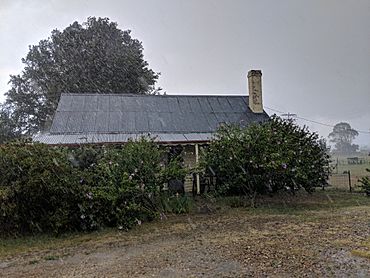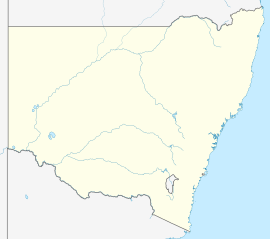Jembaicumbene facts for kids
Quick facts for kids JembaicumbeneNew South Wales |
|||||||||||||||
|---|---|---|---|---|---|---|---|---|---|---|---|---|---|---|---|
 |
|||||||||||||||
| Postcode(s) | 2622 | ||||||||||||||
| Location |
|
||||||||||||||
| LGA(s) | Queanbeyan–Palerang Regional Council | ||||||||||||||
| Region | Southern Tablelands | ||||||||||||||
| County | St Vincent | ||||||||||||||
| Parish | Boyle | ||||||||||||||
| State electorate(s) | Monaro | ||||||||||||||
| Federal Division(s) | Eden-Monaro | ||||||||||||||
|
|||||||||||||||
Jembaicumbene (pronounced Jemmi-c'm-bene) is a small area in the Southern Tablelands of New South Wales, Australia. It's about 8 kilometres (5 miles) from Braidwood on the road to Majors Creek. This peaceful valley was once a busy goldfield. The mining village that grew here is now almost a ghost town.
The land around Jembaicumbene traditionally belongs to the Walbanga people. They are a group of the Yuin Aboriginal people. Settlers from Europe began to take over the land in the 1830s.
Contents
Jembaicumbene: A Historic Gold Town
Early Days and Gold Discovery
In 1853, gold was found in Jembaicumbene Creek. This area was then officially declared a goldfield. By 1859, over a thousand gold miners lived along the creek. About 600 of these miners were from China.
A special area was set aside for a village on February 1, 1867. By 1868, the village was thriving. It had many shops, hotels, and businesses. There was even a large flour mill.
The village was just north of Jembaicumbene Creek. This creek flows into the Shoalhaven River. Majors Creek Road was the main street of the village. Some old street names like North, Peel, and Howe Streets still appear on maps today. You can still see old trees where homes used to be. The dug-up earth along the creek shows where miners searched for gold. Later, large machines called dredges also worked here.
The Flour Mill Story
The Jembaicumbene Steam Flour Mills opened in January 1860. Charles Dransfield built it in 1859. A Sydney architect named C. E. Langley designed the building. The machinery, including a 20-horsepower steam engine, came from P. N. Russell & Co.
The mill building is still standing today. It has been used for other things since then. It is the most important building left from the gold rush time.
Gold Dredging and Its Impact
By 1874, the steam mill was still working. But Jembaicumbene was described as a "quiet village." There was still a lot of gold in the swampy creek bed. However, it was hard to get because of all the water.
A new mining method called gold dredging was introduced in New South Wales in 1899. This method was perfect for the wet goldfield. Gold dredges brought back gold mining to Jembaicumbene. This happened from about 1901 until at least 1917. But these large machines also caused a lot of damage to the land.
In 1905, the village still had a hotel, post office, and blacksmith. There was also a school, two churches, and many houses.
Fun and Famous Connections
Horse Racing Excitement
Horse racing was a very popular activity for the miners. The settlers also enjoyed social events around race meetings. These races were held on tracks that are now gone. The annual race meeting at Jembaicumbene was usually on New Year's Day. This tradition lasted from at least 1863 until 1903.
In 1873, a special race meeting was held for Chinese New Year. It was organized by Mei Quong Tart (梅光达). He was a well-known Chinese mine owner and businessman. He came to Australia from China when he was nine years old. Other Chinese community members also helped organize the event.
Archer: A Racing Legend
Jembaicumbene, or nearby Ballalaba, is famous for being the birthplace of Archer. Archer was a very famous racehorse. He won the first two Melbourne Cup races in 1861 and 1862. He was born at "Exeter Farm" and later retired there. People believe he is buried there too. Other Melbourne Cup winners were also bred in this area.
Guboo Ted Thomas: An Aboriginal Leader
There's another interesting link between Jembaicumbene and the horse Archer. Helen "Ellen" de Mestre was the first Aboriginal child of Archer's trainer, Etienne de Mestre. She was born in this area. Some of Etienne's Aboriginal grandchildren and great-grandchildren were also born here.
One of Etienne's great-grandchildren was Guboo Ted Thomas (1909–2002). He became a very important Aboriginal leader. He was a spiritual leader for the South Coast area of New South Wales. This area is also Yuin country. Guboo was the last initiated tribal elder on the South Coast. He was born under a gum tree right in Jembaicumbene.
Jembaicumbene Today
Jembaicumbene had a public school from 1870 to 1934. It was a part-time school for a few years and then a provisional school. The post office opened in 1861 but closed on March 28, 1979. Today, Jembaicumbene is a quiet valley, a reminder of its busy gold rush past.


